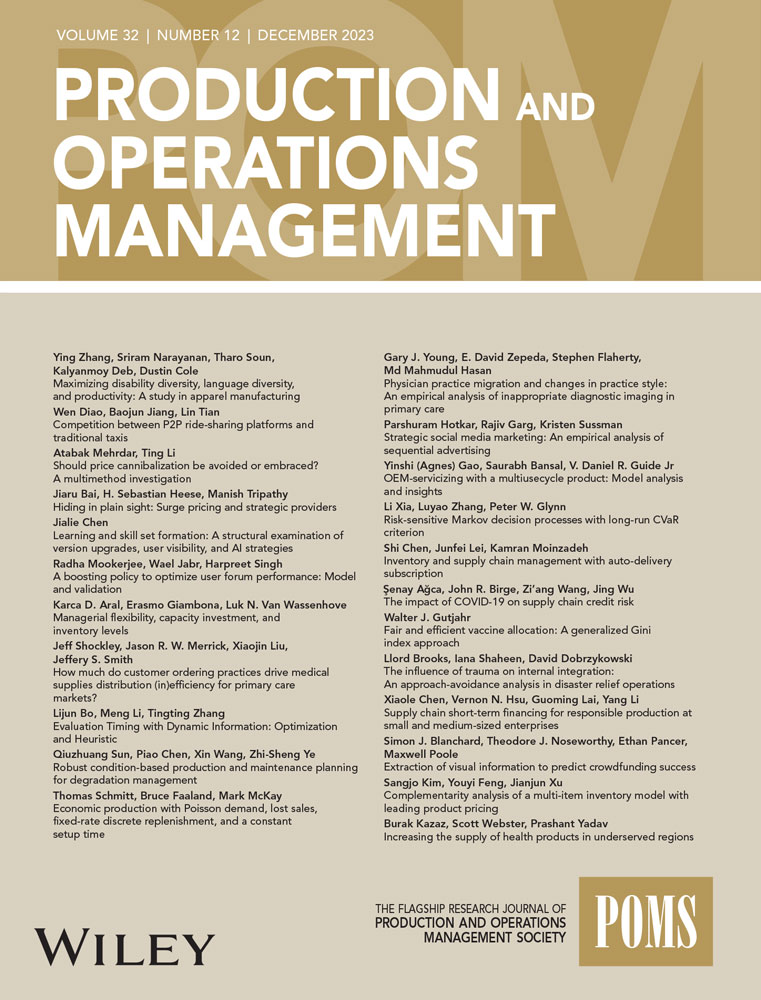EXPRESS: Decentralized Online Order Fulfillment in Omni-Channel Retailers
IF 4.8
3区 管理学
Q1 ENGINEERING, MANUFACTURING
引用次数: 0
Abstract
We consider an order fulfillment problem of an omni-channel retailer that ships online orders from its distribution center (DC) and brick-and-mortar stores. Stores use their local information, not observed by the retailer, that can lead them to accept or reject fulfillment requests of items in an online order. We investigate the problem of sequencing requests to stores and inventory rationing decisions at the DC to minimize expected costs under uncertain store acceptance behavior and when items are indistinguishable in terms of shipping. First, under the scenario that stores are used only when the DC has insufficient inventory, we propose a Markov Decision Process formulation and analyze the performance of myopic policies that are preferable because of their interpretability. We show that the performance rate of a myopic approach that orders stores by cost only depends on the number of items in an order, which is small in practice. We also determine conditions for the range of acceptance probabilities for the myopic policy to be optimal for small-sized orders. Using optimality conditions for a special case of the problem, we develop an adaptive variant of the myopic policy, and propose a new degree-based strategy that balances shipping costs and acceptance probabilities. Numerical testing suggests that the best-performing sequencing policy is within 1% of optimality on average. Moreover, using two years of data from a large omni-channel retailer in North America, we observe that adaptive policies, albeit more complex, are beneficial in reducing costs and split deliveries if acceptance rates can be estimated accurately. Second, we determine when the retailer should ship from stores or ration the inventory at the DC. We show that for single-item orders, the optimal policy has a threshold structure, where, remarkably, the highest priority region is also subject to rationing. We then consider the novel multi-unit-single-item rationing problem, and leverage the structure of the single-unit model to develop a heuristic. We numerically establish the efficacy of rationing models and our heuristic.快递:全渠道零售商的分散式在线订单执行
我们考虑的是一个全渠道零售商的订单履行问题,该零售商从其配送中心(DC)和实体店发送在线订单。实体店使用零售商无法观察到的本地信息,这些信息会导致它们接受或拒绝在线订单中商品的履行请求。我们研究了在商店接受行为不确定和商品运输不可区分的情况下,如何确定向商店发出请求的先后顺序并在配送中心做出库存配给决策,以最大限度地降低预期成本的问题。首先,在只有当配送中心库存不足时才使用门店的情况下,我们提出了马尔可夫决策过程公式,并分析了因其可解释性而更可取的近视政策的性能。我们表明,按成本订购仓库的近视方法的绩效率仅取决于订单中的物品数量,而这在实践中是很小的。我们还确定了小规模订单中近视策略最优接受概率范围的条件。利用问题特例的最优性条件,我们开发了近视策略的自适应变体,并提出了一种基于度数的新策略,以平衡运输成本和接受概率。数值测试表明,最佳排序策略的平均最优化率在 1%以内。此外,利用北美一家大型全渠道零售商两年的数据,我们观察到,如果能准确估计收货率,自适应策略虽然更复杂,但有利于降低成本和分批交付。其次,我们确定零售商何时应从商店发货或在配送中心配给库存。我们的研究表明,对于单品订单,最优政策具有阈值结构,其中最优先区域也需要进行配给。然后,我们考虑了新颖的多单位-单品配给问题,并利用单单位模型的结构开发了一种启发式方法。我们用数字证明了配给模型和启发式的有效性。
本文章由计算机程序翻译,如有差异,请以英文原文为准。
求助全文
约1分钟内获得全文
求助全文
来源期刊

Production and Operations Management
管理科学-工程:制造
CiteScore
7.50
自引率
16.00%
发文量
278
审稿时长
24 months
期刊介绍:
The mission of Production and Operations Management is to serve as the flagship research journal in operations management in manufacturing and services. The journal publishes scientific research into the problems, interest, and concerns of managers who manage product and process design, operations, and supply chains. It covers all topics in product and process design, operations, and supply chain management and welcomes papers using any research paradigm.
 求助内容:
求助内容: 应助结果提醒方式:
应助结果提醒方式:


